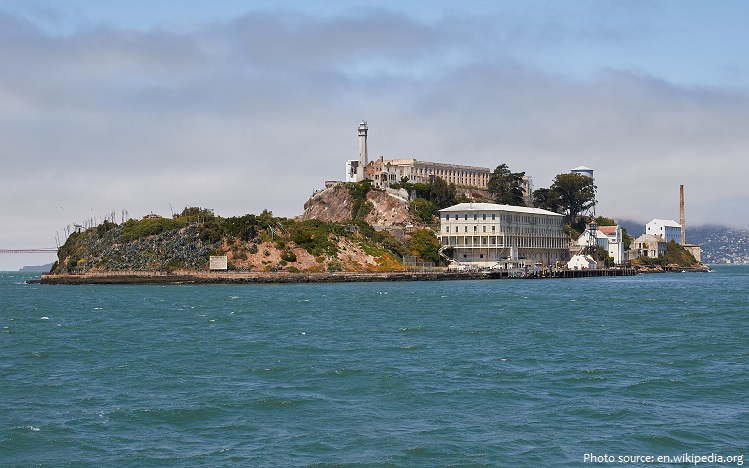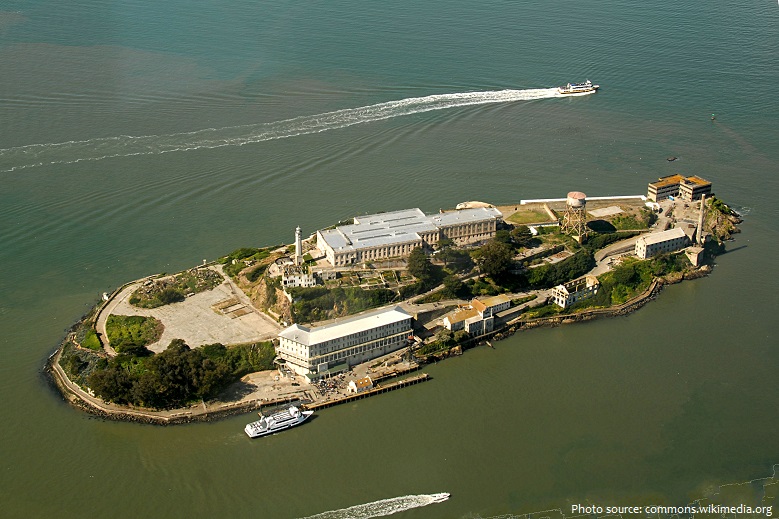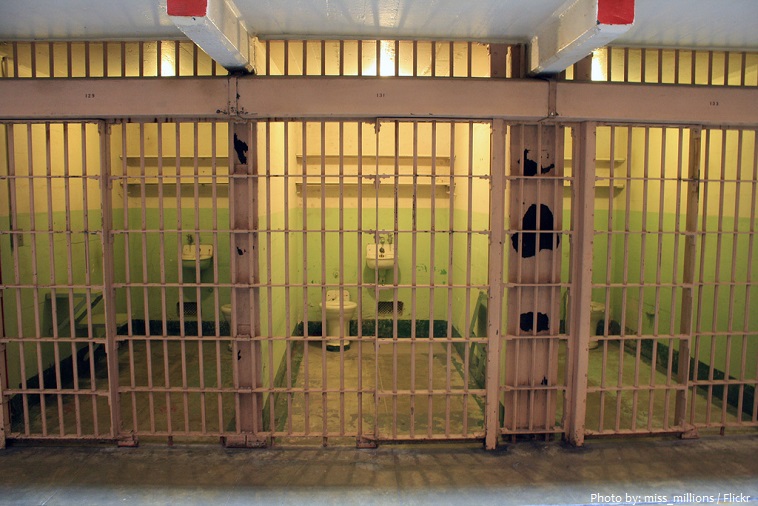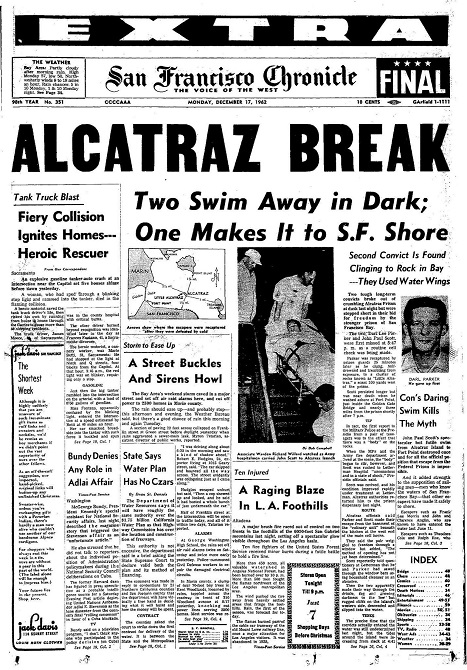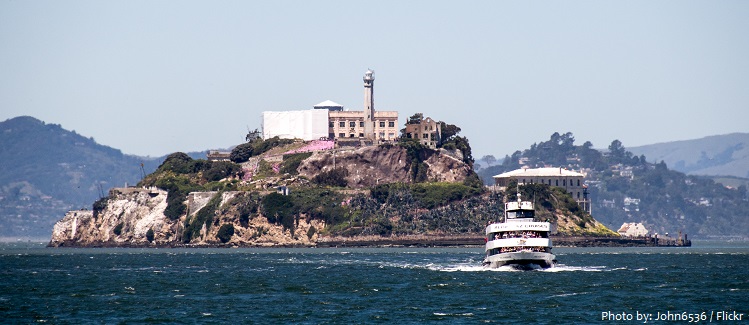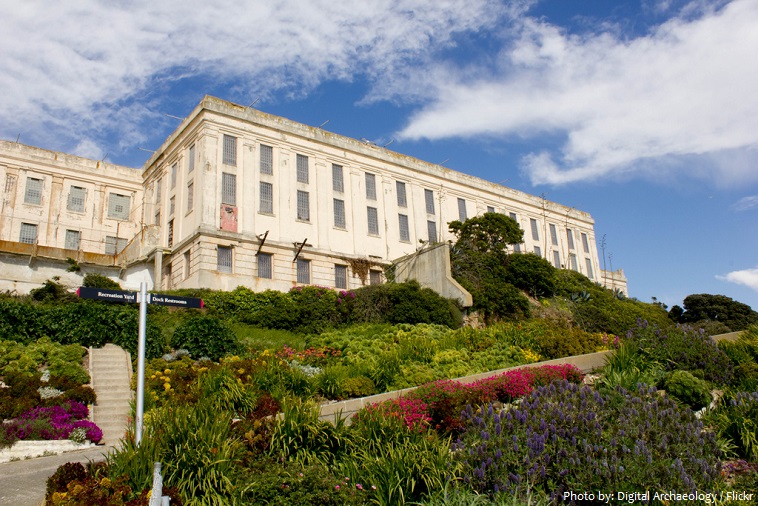Alcatraz also known as The Rock was a maximum high-security federal prison from 1934 until 1963.
It is located on Alcatraz Island. The island is located in San Francisco Bay, 2 kilometers (1.25 miles) offshore from San Francisco, California, United States.
The first European to document the island was Juan Manuel Diaz, who charted San Francisco Bay and named one of the three islands he identified as “La Isla de los Alcatraces,” which translates as “The Island of the Gannets” but is commonly believed to translate as “The Island of the Pelicans”.
The small island was developed with facilities for a lighthouse, a military fortification, a military prison, and a federal prison.
Alcatraz, originally envisioned as a naval defense fortification, was designated a residence for military offenders in 1861, and it housed a diverse collection of prisoners in its early years. These included 19 Hopi Indians from the Arizona Territory who passively resisted government attempts to assimilate them, and American soldiers fighting in the Philippine-American War who had joined the Filipino cause in 1900.
In 1907 the island was designated the Pacific Branch of the United States Military Prison, and the modern prison building was completed four years later.
Given its isolated location and impenetrable reputation, Alcatraz dealt with the most incorrigible prisoners in federal prisons and demonstrated that the federal government was taking a more punitive approach to rampant crime and the notorious criminals of the 1920s and 1930s.
Alcatraz was designed to hold prisoners who continuously caused trouble at other federal prisons.
One of the world’s most notorious and best known prisons over the years, Alcatraz housed some 1,576 of America’s most ruthless criminals including Al Capone, Robert Franklin Stroud (the “Birdman of Alcatraz”), George “Machine Gun” Kelly, Bumpy Johnson, Rafael Cancel Miranda, Mickey Cohen, Arthur R. “Doc” Barker, Whitey Bulger, and Alvin “Creepy” Karpis (who served more time at Alcatraz than any other inmate).
The three-story cellhouse included the main four blocks of the jail, A-block, B-block, C-block, and D-block, the warden’s office, visitation room, the library, and the barber shop.
The prison cells typically measured 2.7 meters (9 feet) by 1.5 meters (5 feet) and 2.1 meters (7 feet) high. The cells were primitive and lacked privacy, with a bed, a desk and a washbasin and toilet on the back wall, with few furnishings except a blanket.
African-Americans were segregated from the rest in cell designation due to racial abuse being prevalent.
D-Block housed the worst inmates and five cells at the end of it were designated as “The Hole”, where badly behaving prisoners would be sent for periods of punishment, often brutally so.
Corridors of the prison were named after major American streets such as Broadway and Michigan Avenue.
Of the 36 inmates who staged 14 escape attempts over the 29 years that Alcatraz served as a federal penitentiary, 23 were recaptured, six were shot and killed, two drowned, and five (including Morris and the Anglins) are listed as missing and presumed drowned.
One daring escape was popularized in the Clint Eastwood film Escape from Alcatraz (1979).
Eventually the cost associated with maintaining the prison, particularly the expense of transporting fresh water to and waste away from it, resulted in the closing of the facility after operating for 29 years, on March 21, 1963.
From November 20, 1969, to June 11, 1971, the island was occupied by Native American activists, including members of the American Indian Movement, who were protesting what they saw as the U.S. government’s ongoing economic, social, and political neglect of Native Americans.
In 1972 the prison and its grounds became part of the newly created Golden Gate National Recreation Area, and Alcatraz remains one of San Francisco’s most popular tourist destinations.
Today the penitentiary is a public museum and one of San Francisco’s major tourist attractions, attracting some 1.5 million visitors annually.
Alcatraz Island is considered one of the most haunted places in America. Its legends and lore history and stories haunt the visitors who walk the hallways of the abandoned concrete building.
For more than a century, gardens were an important part of everyday life for officers, families, and prisoners confined to Alcatraz by sentence or duty. Many of the plants selected by these unheralded gardeners proved to be excellent choices for the harsh and barren environment, flourishing through the four decades of neglect that followed the prison’s closing. Restored in 2003, the gardens are now known as the “Gardens of Alcatraz”.
The annual public Escape from Alcatraz triathlon, organized by IMG, now takes place in early June. The current course consists of a 2.4 kilometers (1.5 mile) swim starting near Alcatraz Island, an 800 meters (0.5 mile) run from the bay to the transition zone at Marina Green, a 29 kilometers (18-mile) bike ride, and a 13 kilometers (8 miles) run.
Alcatraz Island is great place for bird watching. There are many species of birds on the island including falcons, ravens, hawks, cormorants, herons, western gulls, pigeon guillemots, black oystercatchers, black-crowned night herons, great egrets, and snowy egrets.
